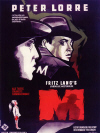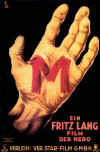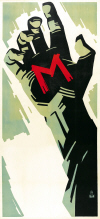
 The
economy, austerity and directness of the films of Fritz Lang made him one of
the most profound, and precise filmmakers. Lang, a master of the German
expressionist film, shot his first talkie, a crime drama considered a
landmark in the story of suspense movies. It was a shocking idea for its
time, based on the real-life killer Peter Kurten, headlined as the Vampire
of Düsseldorf. The
economy, austerity and directness of the films of Fritz Lang made him one of
the most profound, and precise filmmakers. Lang, a master of the German
expressionist film, shot his first talkie, a crime drama considered a
landmark in the story of suspense movies. It was a shocking idea for its
time, based on the real-life killer Peter Kurten, headlined as the Vampire
of Düsseldorf.
'M' is about a terrorized city, and a plump
little man with wide eyes (often chewing candy) who is a pathological
child-killer, unable to control his urge for killing. The film embodies
several Lang themes: the duality between justice and revenge, mob hysteria,
the menacing anticipation of watching a helplessly trapped individual trying
fruitlessly to escape as greater forces move inexorably in, and, for
probably the first time in the cinema, it adds a new dimension to suspense:
pity. For the killer is clearly mentally sick―he cannot overcome the
overwhelming compulsion of his murderous disease, and yet, we see him hunted
down and almost lynched as a criminal, rather than treated as a sick man.
Early in the film, the killer is heard whistling
the Grieg theme from 'In the Hall of the Mountain King'. This theme
inexorably becomes imbued with menace. And when we see no more than a
girl looking in a shop window, the melody on the soundtrack tells us
chillingly that the murderer is there, just out of sight.
  The Murderer is played by
Peter Lorre in a virtuoso
performance that has barely been matched in all the thrillers he has made
since
Casablanca,
The Maltese Falcon, and
The Mask of Dimitrios. When the photographs of his victims, all
little girls, are shown to him, he jumps back and twitches with horror. The Murderer is played by
Peter Lorre in a virtuoso
performance that has barely been matched in all the thrillers he has made
since
Casablanca,
The Maltese Falcon, and
The Mask of Dimitrios. When the photographs of his victims, all
little girls, are shown to him, he jumps back and twitches with horror.
With powerful visuals, Lang's motion picture was
Lorre's first film. His performance as the corpulent, hunted
psychopath was a masterpiece of mime and suggestion. Lorre was the
archetypal outsider―outside the law and society because of his compulsive
crimes, outside the balancing society of the underworld because he was not a
professional criminal. He had only twelve lines of dialog.
In the most famous of all about a pathological
killer―Alfred Hitchcock's
Psycho―Anthony Perkins lacked not only the
threat of the tortured
Peter Lorre, but also the
dimension of invoking our incredulous sympathy.
Psycho reeked with blood and horror,
whereas the suspense of M is subtle: a child's balloon without
an owner and a rolling ball are enough to tell us that another murder had
been committed. The audience, trapped in its seats, torn by ambivalent
feelings towards the killer, watched him trapped as the net was pulled
tight. |
